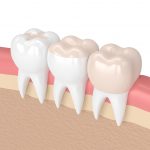WHAT DO INLAY AND ONLAY MEAN?
These are fillings made by a dental technician after cavitation and print taking. Inlays are made in dental laboratories to restore the original shape and contour of the tooth. The smaller extension is called Inlay, Onlay has a larger dental insert that surrounds the tooth surface.
WHEN ARE INLAYS AND ONLAYS DONE?
Filling of the teeth is one of the most common dental interventions, which in best case does not affect the deeper tooth layers. Sometimes, however, the hole is so large that it is not feasible with conventional materials and techniques.
There are cases in which there is so much material deficiency after the removal of the carious areas or the weakened dentures that the teeth can not be rescued aesthetically and precisely with a normal filling. In such cases, the use of so-called inlays or onlays is recommended.
During the development of caries, the molars are often damaged over a large area. In such cases, the entire upper part must be polished. Occasionally, when tooth decay touches the depth of the tooth and creates a crater-like cavity, the tooth can suddenly break open. The cause of this degree of caries is mostly due to the food intake between the teeth and inadequate dental care. Since tooth decay begins in a hidden place, sometimes on the side of the tooth, it can not properly be cleaned by the toothbrush and the tooth decay spreads to the inside of the tooth. In the worst case, nothing is visible on the tooth surface, and suddenly the patient gets terrible pain because tooth decay reaches the tooth interior. When the inside of the tooth is damaged, the outer erosion of the tooth begins very quickly, followed by peeling, jerking and rebounding, so the inner crater becomes visible.


INLAY OR FILLING?
An aesthetic filling can usually be used to moderate decay, if a large number of healthy parts remain from the tooth. If our tooth has such decay, or is so broken that it can not be corrected with tooth filling, inlay is the perfect solution to avoid the crowns.
WHAT ARE INLAYS AND ONLAYS MADE OF?
- Porcelain inlay: The insert is made of pure porcelain. More demanding than any other modified ceramic inlay – with exact dental and technical work, as well as correct color selection, it is the perfect complement to the original tooth enamel.
- Gold inlay: Out of all inlays, this inlay has the best edge closure, making it the safest of them all. In most cases, this otherwise excellent and possibly best and most durable refill option will be rejected by patients for their high gold price or esthetics.

INLAY OR FILLING?
An aesthetic filling can usually be used to moderate decay, if a large number of healthy parts remain from the tooth. If our tooth has such decay, or is so broken that it can not be corrected with tooth filling, inlay is the perfect solution to avoid the crowns.
- Inlay / onlay inserts can be used to salvage the remainder of the tooth, eliminating the need for extraction and replacement
- The colors of inlays and onlays adapt perfectly to their environment so that they are invisible
- Inlay and onlay inserts provide better edge closure than composite fillings
- An inlay returns the individual anatomical shape of the tooth much better
- Inlays facilitate the creation of individual chewing zones
- An inlay or onlay provides a perfect contact point between adjacent teeth
- The inlay restores the missing tooth parts permanently
- When making inlays, teeth whitening is not needed
- Can also be used to replace missing teeth (inlays with anchored bridges).
- Inlays are extremely accurate and therefore comfortable to wear
- The caustics are excellent
- Inlays do not cause allergic reactions
- The probability of secondary caries is much lower with appropriate oral care
HOW ARE INLAYS MADE?
The insertion of inlays or onlays begins with a local anaesthetic. After that, the doctor creates a special cavity by removing the carious parts. In this cavity comes later the inlay. An impression and a bite pattern are made from the cavity, and the appropriate color is selected. These are sent to the dental technician who makes the inlay. The cavity is closed with a temporary filling to protect the tooth. After three working days, the inlay is attached.

